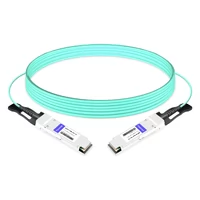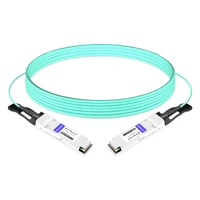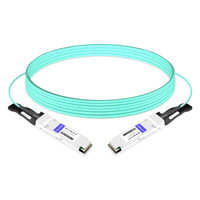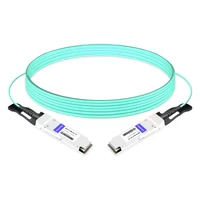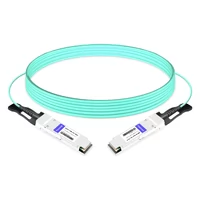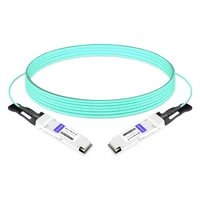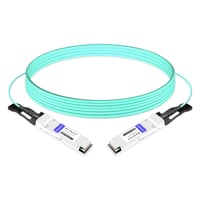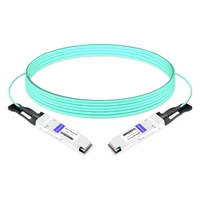AOC or Active Optical Cables can be described as a new way of transmitting data by leveraging the strength of optical fiber connections and building a slimmer, easier-to-use cable. Thanks to their design, even with less than optimal connections, AOC can operate over a vast distance; this also helps in the scenario of a data center, high-performance computers, and electronic devices that need a high data transfer rate. Including AOC active cables in optical fibers increases the bandwidth, reliability, and immunity to electromagnetic interference. This paper will explain AOC technology’s technical specifications, benefits, and use cases, which will help the reader understand why AOC connections are becoming more common in communication models.
Table of Contents
ToggleWhat is an Active Optical Cable, and How Does it Work?
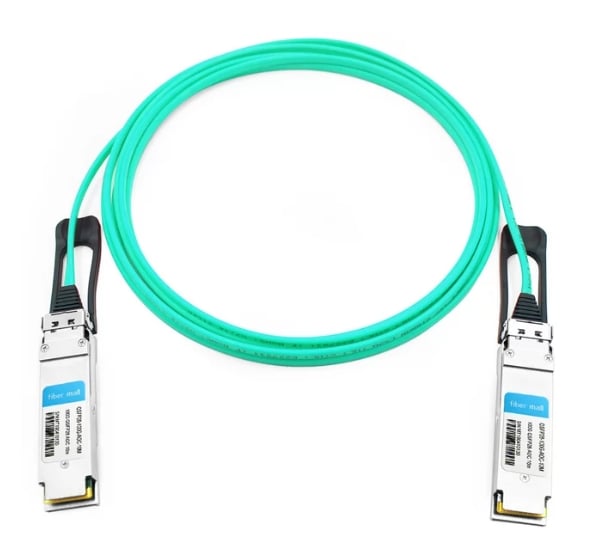
Active Optical Cables (AOCs) represent highly sophisticated data transmission solutions based on optical fiber elements that send data through optical rather than electrical signals. AOCs include a lightwave transmission module that receives and sends electrical and optical signals. This allows long-distance transmission of data without loss on the amplitude of the signal, which would otherwise be reduced if copper cables were used. The easy and ergonomic structure of AOCs, along with greater bandwidth and complete electromagnetic interference effectiveness, render them an attractive solution to high-dense applications such as data centers and high-end computing applications. These cables are built to provide plug-and-play capabilities, so their installation and connection to already deployed systems should not be a hassle.
Understanding the Basics of AOC Cables
Active Optical Cables (AOCs) are exciting products as they provide both the functionalities of a standard electrical cable and the high-speed characteristic of fiber optics. This enables AOCs to transfer information at much higher rates, typically more than 100Gbps, while being more efficient and having less attenuation even over long links. Such cables have a fiber optic core with a cover, making it possible to send information as light pulses and making it suitable for passive cable use. AOCs are also well suited for high-frequency fitting environments since optical fibers make them immune to electromagnetic interference. In addition, they have integrated transceivers that can translate electrical and optical signals, enabling them to be used in the already-built network. As technology grows, the need for even greater bandwidth and lower latency with better timing accuracy in the transmitted data will improve AOCs’ relevance in modern communication networks.
How Fiber Optic Technology Powers AOCs
Essential takeaways can be summarized to better understand how fiber optic technology informs Active Optical Cables (AOCs). Essentially, fiber optics comprises several fragile glass or plastic strands forming the core data transmission medium. This technology allows AOCs to employ long reach while achieving high speed with little reduction in power signals. Light as a carrier medium provides these cables with an almost limitless bandwidth, essential vis-à-vis the growing need for high-capacity data transfer in modern-day computing systems. Further, because light is a carrier, these cables are not susceptible to electromagnetic interference, enhancing signal quality and consistency. Ultimately, the employment of fiber optic technology within AOCs creates an ecosystem that is very efficient and effective, which is critical for use within data centers and high-speed telecommunication networks.
The Role of Transceivers in AOC Functionality
A transceiver performs a vital role in an Active Optical Cable (AOC) since it connects the electronic and the optical networks by converting electricity into light or vice versa. Augmenting this feature, AOCs can easily connect to electronic and optical networks. Transceivers can house both the transmitter and the receiver modules, enabling data communication in both directions across long distances with low-voltage transmission loss. Their accurate design allows high-speed transmission of data. Hence, they satisfy the growing demand and requirements in communication regarding the quality of information, transfer rate, and system reliability in data centers and telecommunication systems.
Why Choose AOC Over DAC?
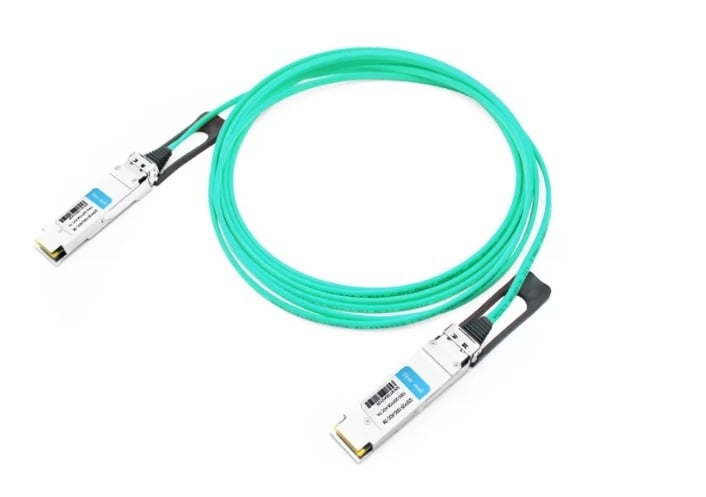
Comparing AOC vs DAC: Key Differences
Significant distinctions exist between active optical cables (AOCs) and direct attach cables (DACs), which enable their application across multiple dimensions. Firstly, the AOCs employ fiber optics technology, which is better than DACs that utilize copper cables since it can provide improved data transfer rate and transmission distance. Although less expensive, DACs are ideal for connections within or to the adjacent rack. AOCs are preferable for long-distance applications such as data centers since they maintain maximum signal quality while excluding electromagnetic interference. AOCs are also lightweight and more flexible, so they are suitable in weight and bend-radius-constrained environments like those found in aircraft. Ultimately, the selection of AOC or DAC is determined by specific facets, including distance, cost, and environment, particularly the HDMI active optical cable application.
The Advantages of AOC in Modern Data Centers
Active Optical Cables (AOCs) have many benefits, making them particularly fit for usage in modern data centers. To begin with, AOCs show an improved bandwidth capability, which is one of the basic requirements of high-performance computing tasks and operations that demand an increasing amount of data to be processed. The increase in bandwidth availability is also very significant in the ability to address the data flow requirements imposed by the latest cloud-based and enterprise-based applications. Moreover, AOCs achieve better signal transmission quality when deployed over long distances than copper cables, enabling good performance over a more significant number of nodes in a large data center. In addition, AOCs being light and wanting less space also help minimize cable management and reduce the effect of infrastructure, which is essential for adequate use of space and economy in data centers. All these factors, plus the fact that AOCs are resistant to electromagnetic interference, suggest that AOCs are the way to go if you want to improve the efficiency and scalability of data centers, especially when setups based on fiber optic cables are used.
Understanding Direct Attach Technologies
Secure connections between various electronic equipment, including switches, routers, storage controllers, and direct-attach cables (DACs), are used. However, their utilization is limited due to their low bandwidth between communication devices. Fabricating these devices involves a cable and transceiver integrated into the same unit, making it easier to deploy. Although the performance of these devices is not as strong due to their small distances and low bandwidth, they have a lot of advantages. Some include cost and power consumption. However, the benefits do outweigh the performance limitations, where they can sufficiently be used for short distances due to the low latency. Most importantly, they are affordable and easy to install, so even in areas where the signal latency is high and power consumption is less will allow for DAC to be deployed. Furthermore, the revolution of technologies that require data has increased, so the demand for these devices will continue to rise.
Exploring QSFP28 Active Optical Cables
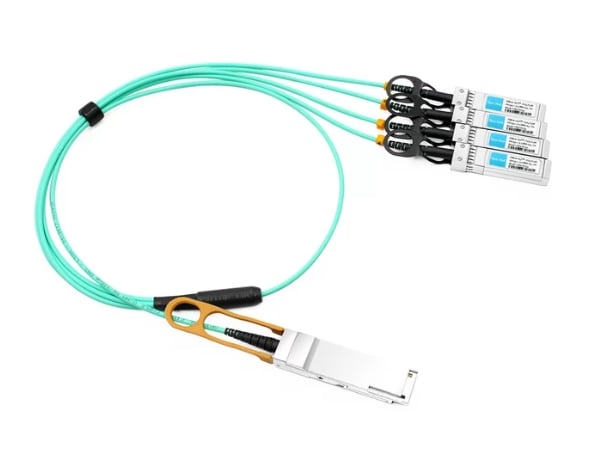
What Sets QSFP28 AOC Apart?
Scanning through the essential aspects of QSFPP28 AOC, it can be said that the primary benefit it provides is the fact that it can process data of up to 100 GBS, which is very useful to the data centers of today, which requires larger amounts of data to be sent across. QSFPP28 AOC’s various capabilities make this the case, as one AOC decreases the congestion while seamlessly working on more extensive infrastructures. These advanced features, coupled with their compact size and lightweight, make AOC management very easy, as there is less mesh around the equipment racks. Along with the features to transform information at an incredible speed and reduce the amount of energy and EM interference, it is easy to consider the AOC as a state-of-the-art technology. This technology is of utmost necessity for the noticeable computing environments.
Applications of 100G QSFP28 AOC in Networks
I have highlighted that the application of 100G QSFP28 AOC in the networks has several areas where these cables stand out; these interconnects have high bandwidth requirements with low latency, which is imperative in data centers where AOCs are interfaced. They also supported the crat quarters, where they were always crunched. Besides, their active optical cable interconnects collocate with sophisticated computing capabilities. Some of their uses extend to parts of enterprise networks, considering how they are used in networks that span campuses. Their cable technologies are such that data loss is minimal, and there are no outages, furthering recent trends in very high-speed, highly scalable energy-economizing networks.
Ensuring Compatibility with Optical Transceivers
There are key aspects to note when verifying optical transceiver requirements. To begin with, the interface’s physical and protocol standards are examined, for example, IEEE 802.3, to ensure a match between the transceiver and the equipment in question. It is also necessary to check manufacturers’ compatibility lists with the supported devices and configurations. Also, I try to determine whether optical requirements such as wavelength and transmission distance would be met. These steps, in conjunction with firmware releases and the use of appropriate types of fiber, guarantee the smooth functioning of the network together with acceptable performance and reliability.
The Future of Optical Networks with AOC Technology
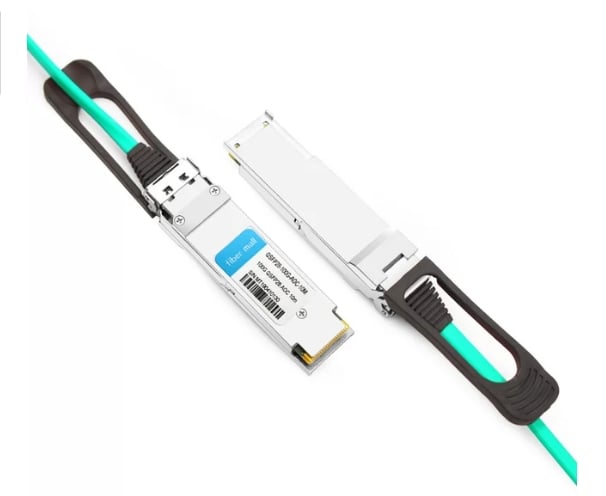
Emerging Trends in Optical Communication
Optical communication is rapidly developing due to increasing data and technological improvements, especially concerning fiber optic cables. One of the key trends is the use of machine learning (ML) algorithms to strive for the efficiency of the network and its dynamic management of data traffic. This method promotes better utilization of resources by minimizing delays and increasing volume capabilities, which are crucial for the encompassing AOC applications in contemporary systems. Moreover, creating Photonic Integrated Circuits (PICs) changes the picture by providing miniaturized and energy-efficient data interchange. Also, progress in the spectral efficiency of Dense Wavelength Division Multiplexing (DWDM) technology makes it possible to support higher data rates consistent with the increasing demand for fast and reliable internet services. These new tendencies show that optical communication systems will be more pliable, robust, and efficient in the coming times.
Integrating QSFP28 Active Optical Solutions
Incorporating QSFP28 active optical solutions is crucial to the upgrading of network infrastructures in order to effectively respond to the growing needs for high bandwidth and low latency. According to the leading sources, the AOCs of QSFP28 offer the best, more straightforward way of establishing 100G Ethernet, especially because this type of connectivity does not require complicated configurations as it is plug-and-play. Such solutions are intended for applications in high-density data centers and operate at higher performance while consuming less power. Industry experts also agree that the acquisition of QSFP28 as part of the expansion of network systems improves the efficiency of its operations, which is a crucial consideration for the longevity of large systems. When assimilating such changes, the issues of how this will fit into the already existing network and what will come in the future are fundamental since they are strategic to improving the system’s performance and possible reach.
The Impact of AOCs on Data Transmission Efficiency
By utilizing minimal distances and boosting signal strength, Active Optical Cables (AOCs) manage to improve the data transfer quality. As the most reputable technology sources emphasize, AOCs use optical fiber technology with better bandwidth properties and lower electromagnetic interference than wire copper cables. Consequently, this makes transferring information via high speed essential for supercomputers, data hubs, and computing clouds. In addition, other benefits include lighter weight and lower complexity of bulk cabling systems; these factors contribute to enhancing network operations. These cables provide the necessary capacity and reliability to address the increasing needs of modern networks, which deal with more complicated data traffic patterns.
Reference Sources
Frequently Asked Questions (FAQs)
Q: What is Cable AOC, and how is it different from a DAC cable?
A: An AOC cable, or an Active Optical Cable, forms a firm connection by transmitting data through the fiber optic instead of a DAC(Direct Attach Copper) cable, which AOC does not. AOC cables tend to be more efficient as they use a signal converter at the ends of the cable rather than the whole transducer, allowing them to achieve a greater range while maintaining very low latency compared to a copper cable.
Q: What are the advantages of using AOC over traditional fiber cables?
A: Compared to traditional fiber cables, AOCs are much easier to utilize thanks to their comparatively low power consumption, less latency, and lack of the need for an external transceiver for installation. Additionally, AOCs can support more compact solutions for high-wire density applications like data storage environments, which come in many form factors, including QSFP and SFP.
Q: Can AOC Ethernet connections be used?
A: Ethernet connections are likelier to use AOC, especially in data centers and supercomputing devices. High-bandwidth applications can benefit from Ethernet, which AOC provides in various ultra-wide bandwidths of 40G, 100G, 200G, and 400G.
Q: What is a breakout AOC, and when is it used?
A: A breakout AOC is an active optical cable that extends a high-speed port into many lower-speed ones. For instance, a 40G QSFP breakout AOC connecting to four 10G SFP ports has one 40G port on one side and four 10G ports on the other. This is useful in connecting a number of low-speed devices through a single high-speed switch or increasing the switch’s port density.
Q: How do AOC connectors differ from traditional optical connectors?
A: The plug and the AOC differ from the standard connectors in that, in the case of AOC, the optical-electrical conversion components are incorporated inside the connector rather than in a different transceiver module. This allows AOCs to function as easy cables that only need to be inserted into the devices rather than connected with an optical transceiver. Various AOC cable terminators are available, including QSFP and SFP connectors.
Q: What lengths does AOC offer, and how are these related to DAC?
A: AOCs have a variety of lengths, ranging from 1m to 100m or even more, depending on the product and data rate. This is significantly greater than the scope of DAC, which in this context would be 5 to 7 meters. For instance, with AOCs, you can also get cables with lengths of 1m, 3m, 5m, or 10m, which gives them more room to be used in data center setups and connections between or within racks.
Q: Overall, what is the performance of an AOC as compared to an active optic cable?
A: As such, there is no real difference between an AOC and an active optical cable as they are both more or less the same and are, most of the time, purchased alongside a fiber optic cable. Each end of the cable has a port/converter that interprets the cables’ signals from electrical to optical. These cables perform well, have low latency, and are well suited for data centers or high-performance computer sets, especially ones that use 100G AOC solutions. The main difference is in the vocabulary since most of the time, “AOC” is prevalent in the market.
Q: Is it possible to connect Cisco routers and switches using AOC?
A: Yes, AOC works with several Cisco routers and switches, as well as devices from other prominent manufacturers. AOCs are meant to be vendor-agnostic products and tend to be plug-and-play replacements for conventional optical transceivers and fiber patching across a range of networking blends.
Q: What do passive copper cables differentiate themselves from AOC cables?
A: The primary distinctions include AOC and passive copper cables such as direct attached copper cable, its transmission medium, and signal management. AOC applies optical fiber to transmit information while undertaking active signal conversion, whereas passive copper cables depend on electric signals from a copper wire. Extended reach, wider bandwidth, and increased EMI resistance are features found in AOC, which passive copper cables do not have.
Q: Are there any custom AOC products that meet high-speed requirements?
A: Yes, there are active optical cable products like the QSFP DD 200G AOC or 400G AOC solutions made for high-speed applications. These AOCs, which target modern data center environments and high-performance computing, are useful where there is a high demand for bandwidth; hence, they are reliable.
Related Products:
-
 QSFP28-100G-AOC-1M 1m (3ft) 100G QSFP28 to QSFP28 Active Optical Cable
$85.00
QSFP28-100G-AOC-1M 1m (3ft) 100G QSFP28 to QSFP28 Active Optical Cable
$85.00
-
 QSFP28-100G-AOC-3M 3m (10ft) 100G QSFP28 to QSFP28 Active Optical Cable
$88.00
QSFP28-100G-AOC-3M 3m (10ft) 100G QSFP28 to QSFP28 Active Optical Cable
$88.00
-
 QSFP28-100G-AOC-5M 5m (16ft) 100G QSFP28 to QSFP28 Active Optical Cable
$90.00
QSFP28-100G-AOC-5M 5m (16ft) 100G QSFP28 to QSFP28 Active Optical Cable
$90.00
-
 QSFP28-100G-AOC-7M 7m (23ft) 100G QSFP28 to QSFP28 Active Optical Cable
$95.00
QSFP28-100G-AOC-7M 7m (23ft) 100G QSFP28 to QSFP28 Active Optical Cable
$95.00
-
 QSFP28-100G-AOC-50CM 50cm (1.6ft) 100G QSFP28 to QSFP28 Active Optical Cable
$84.00
QSFP28-100G-AOC-50CM 50cm (1.6ft) 100G QSFP28 to QSFP28 Active Optical Cable
$84.00
-
 QSFP28-100G-AOC-10M 10m (33ft) 100G QSFP28 to QSFP28 Active Optical Cable
$98.00
QSFP28-100G-AOC-10M 10m (33ft) 100G QSFP28 to QSFP28 Active Optical Cable
$98.00
-
 QSFP28-100G-AOC-2M 2m (7ft) 100G QSFP28 to QSFP28 Active Optical Cable
$86.00
QSFP28-100G-AOC-2M 2m (7ft) 100G QSFP28 to QSFP28 Active Optical Cable
$86.00
-
 QSFP28-100G-AOC-15M 15m (49ft) 100G QSFP28 to QSFP28 Active Optical Cable
$103.00
QSFP28-100G-AOC-15M 15m (49ft) 100G QSFP28 to QSFP28 Active Optical Cable
$103.00

